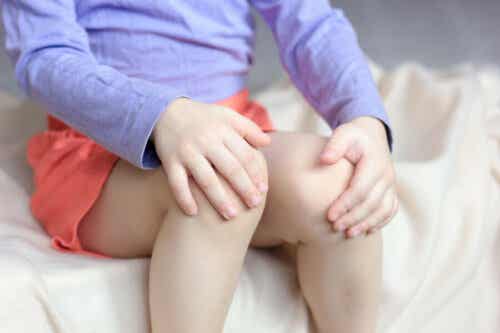Hip Synovitis in Children: What You Need to Know

Synovitis is an inflammation of the hip and is the most common cause of hip pain in children. Although it’s a benign condition, it can often cause concern to parents. Here, we’ll tell you everything you should know about hip synovitis in children.
What is hip synovitis in children?
Synovitis of the hip is inflammation of the synovial tissue. This tissue lines the joints and is responsible for cushioning and lubricating the joints so that they can move without difficulty. Synovitis of the hip mainly affects children between 3 and 10 years of age.
This pathology is also known as transient synovitis of the hip. This is because the inflammation of the joint tends to heal on its own and disappear in a few days, even without treatment. Sometimes the condition may recur several times during childhood.

What’s the cause of synovitis?
Currently, there’s still no known exact cause for this process. However, experts have related it to certain circumstances, although this isn’t always the case. Some of them are:
- A history of blow or trauma to the child’s hip. This doesn’t have to be a major blow. Many times, neither the child nor the family remembers it.
- Recent viral infection of the respiratory tract. These can be, for example, pharyngitis or otitis.
- Children allergic to different substances seem to have a greater predisposition to developing synovitis.
You may be interested in: Tips to Handle Growing Pains in Children
What are the symptoms of hip synovitis?
Inflammation of the synovial tissue increases the amount of fluid inside the joint. Since this is a small space, this will lead to problems.
The most common symptom of synovitis is hip pain. It starts abruptly and increases in intensity. The groin or inner thigh may also ache. In addition, because of the pain, the child may also have a limp or limited hip movement.
This inflammation may affect one or both hips at the same time. Occasionally, the child may develop a fever along with the pain. Even without treatment, the duration of the condition usually lasts about 10 days. This duration can be variable; from a few days to several weeks longer. After that, the pain and swelling gradually begin to subside and disappear.
What do diagnosis and treatment involve?
In the case a child develops symptoms, it’s important to see a specialist, as they’ll be the one who confirms the diagnosis. Normally, this is done based on a thorough physical examination.

Although, as we’ve mentioned, the condition will eventually resolve itself, the treatment will be aimed at reducing the inflammation more quickly and controlling the pain. For this purpose, the most appropriate treatment is to rest until the pain is relieved and mobility is recovered. In addition, the child can be prescribed anti-inflammatory drugs, such as ibuprofen in the recommended dosage for their age and weight.
You may be interested in: What Are Growth Spurts and How to Deal with the Process?
More information on synovitis of the hip
Hip synovitis is the most frequent cause of hip pain and limping in children. Fortunately, it’s a benign pathology that rarely leaves sequelae and eventually resolves on its own. Complications of this condition can arise from it being confused with other more serious pathologies that require urgent treatment. Some examples are Perthes disease or septic arthritis of the hip.
For this reason, in the event of any symptom, it’s essential that you take the child to see a specialist. The professional will be the one to confirm the diagnosis and determine whether it’s a question of hip synovitis or some other more serious illness.
Synovitis is an inflammation of the hip and is the most common cause of hip pain in children. Although it’s a benign condition, it can often cause concern to parents. Here, we’ll tell you everything you should know about hip synovitis in children.
What is hip synovitis in children?
Synovitis of the hip is inflammation of the synovial tissue. This tissue lines the joints and is responsible for cushioning and lubricating the joints so that they can move without difficulty. Synovitis of the hip mainly affects children between 3 and 10 years of age.
This pathology is also known as transient synovitis of the hip. This is because the inflammation of the joint tends to heal on its own and disappear in a few days, even without treatment. Sometimes the condition may recur several times during childhood.

What’s the cause of synovitis?
Currently, there’s still no known exact cause for this process. However, experts have related it to certain circumstances, although this isn’t always the case. Some of them are:
- A history of blow or trauma to the child’s hip. This doesn’t have to be a major blow. Many times, neither the child nor the family remembers it.
- Recent viral infection of the respiratory tract. These can be, for example, pharyngitis or otitis.
- Children allergic to different substances seem to have a greater predisposition to developing synovitis.
You may be interested in: Tips to Handle Growing Pains in Children
What are the symptoms of hip synovitis?
Inflammation of the synovial tissue increases the amount of fluid inside the joint. Since this is a small space, this will lead to problems.
The most common symptom of synovitis is hip pain. It starts abruptly and increases in intensity. The groin or inner thigh may also ache. In addition, because of the pain, the child may also have a limp or limited hip movement.
This inflammation may affect one or both hips at the same time. Occasionally, the child may develop a fever along with the pain. Even without treatment, the duration of the condition usually lasts about 10 days. This duration can be variable; from a few days to several weeks longer. After that, the pain and swelling gradually begin to subside and disappear.
What do diagnosis and treatment involve?
In the case a child develops symptoms, it’s important to see a specialist, as they’ll be the one who confirms the diagnosis. Normally, this is done based on a thorough physical examination.

Although, as we’ve mentioned, the condition will eventually resolve itself, the treatment will be aimed at reducing the inflammation more quickly and controlling the pain. For this purpose, the most appropriate treatment is to rest until the pain is relieved and mobility is recovered. In addition, the child can be prescribed anti-inflammatory drugs, such as ibuprofen in the recommended dosage for their age and weight.
You may be interested in: What Are Growth Spurts and How to Deal with the Process?
More information on synovitis of the hip
Hip synovitis is the most frequent cause of hip pain and limping in children. Fortunately, it’s a benign pathology that rarely leaves sequelae and eventually resolves on its own. Complications of this condition can arise from it being confused with other more serious pathologies that require urgent treatment. Some examples are Perthes disease or septic arthritis of the hip.
For this reason, in the event of any symptom, it’s essential that you take the child to see a specialist. The professional will be the one to confirm the diagnosis and determine whether it’s a question of hip synovitis or some other more serious illness.
All cited sources were thoroughly reviewed by our team to ensure their quality, reliability, currency, and validity. The bibliography of this article was considered reliable and of academic or scientific accuracy.
- Fernández De Sanmamed Gutiérrez, R., Rosa Meana Moris, A., Reimunde Seoane, E., Tadeo Reyes, S., Gavela Ramón, R., & Jenny Castañeda Rodriguez, L. (2018). Dolor agudo de cadera en niños Objetivos Docentes. In Seram.
- Sanchis Cabanilles, M., & Maruenda Paulino, J. (1987). Sinovitis transitoria de la cadera. Estudio escintilográfico. Revista Española de Cirugía , 163–173.
- Traver Cabrera, P., Miralbes Terraza, S., Alquezar Gonzalez, A., & Galbe Sanchez-Ventura, J. (2014). Cojera en una niña de 20 meses, ¿es siempre una sinovitis de cadera? Pediatria de Atencion Primaria, 16(64), 337–339. https://doi.org/10.4321/s1139-76322014000500012
- Sinovitis de cadera | Asociación Española de Pediatría. (n.d.). Retrieved May 27, 2020, from https://www.aeped.es/rss/en-familia/sinovitis-cadera
This text is provided for informational purposes only and does not replace consultation with a professional. If in doubt, consult your specialist.








